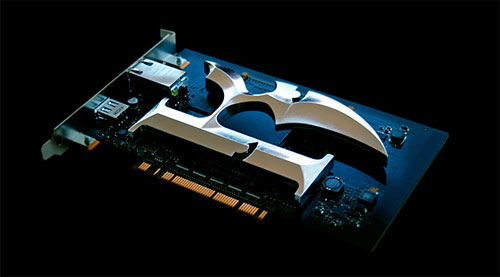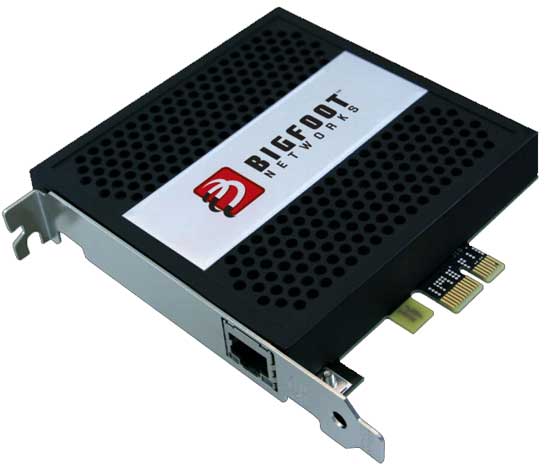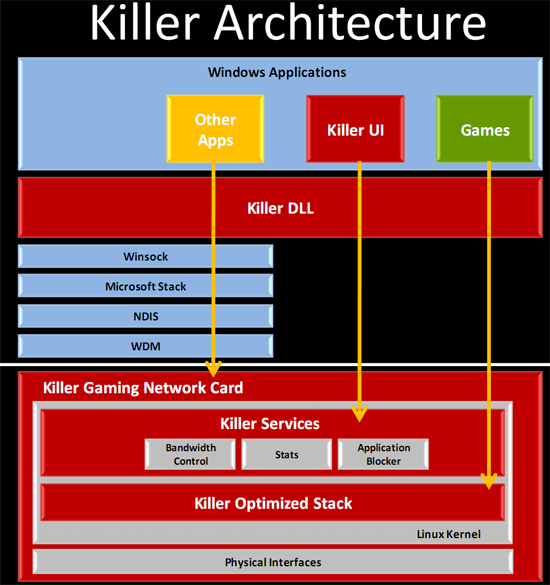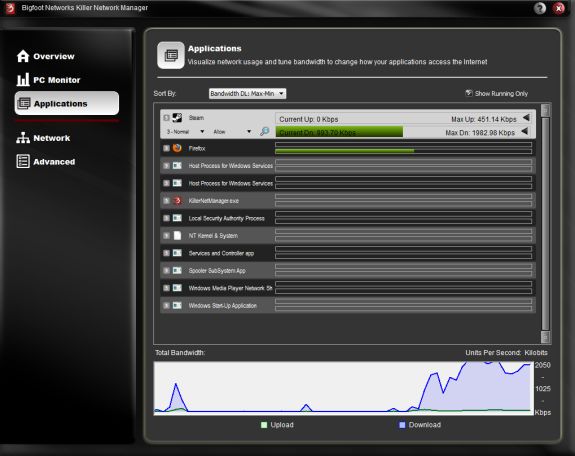Bigfoot Networks Announces 3rd Gen Killer NIC: Killer 2100
by Ryan Smith on May 11, 2010 12:01 AM EST- Posted in
- Networking
- Killer
- NIC
Back in 2006, technology newcomer Bigfoot Networks announced the Killer NIC, an unusual network interface card targeted at the high-end gaming market. With this coming fairly shortly after solid consumer-grade NICs became universally integrated in to motherboards, the timing wasn’t the best. At $280, neither was the price.
The Killer NIC marked a sort of return to the idea of a complex NIC, forgoing a simple controller/PHY combination in favor of a complex dedicated device capable of acting more independently. By endowing a NIC with a full-fledged microcomputer running Linux, not only could the card offload virtually every part of processing required for network operations, but it could even bypass Windows’ notorious networking stack and handle packets in a manner better suited for low-latency use (i.e. games). In turn the Killer NIC would be able offer lower and more stable pings than standard NICs, and with lower CPU overhead increase game/application performance too.

The original Killer NIC in 2006
The reality of the hardware didn’t quite live up to the initial hype. In our review of the original Killer NIC the results were a mixed bag: offloading did improve game performance slightly in CPU-limited situations, but we couldn’t find any significant improvements to ping/latency in games. Ultimately any benefits the card could offer couldn’t justify the $280 price tag even among the high-spending gaming crowd. Later in 2009 they released their second-generation Killer Xeno Pro, but even with a lower price the results were much of the same.
Flash forward to today and Bigfoot Networks has continued their product development unabated, bringing us to their latest product: the Killer 2100. The 2100 is Bigfoot’s 3rd generation Killer NIC, and will be replacing the Killer Xeno Pro. We will be reviewing the card next week when our sample arrives, but ahead of that we wanted to do a quick rundown of what we know thus far after talking to Bigfoot.

The Killer 2100
Let’s start with the hardware:
- 10/100/1000 Ethernet
- PCIe x1 interface
- 400MHz dedicated network processor (PowerPC)
- 128MB DDR2 RAM
Bigfoot tells us that the Killer 2100 hardware isn’t significantly different from the current Killer Xeno Pro. The biggest change is that Bigfoot has ditched all non-Ethernet functionality, dropping the USB port and the 3.5mm audio jacks, leaving only the RJ-45 port. Internally hardware is largely the same. The network processor continues to be an embedded PowerPC CPU, which was likely chosen for PowerPC’s big endian support.
As the hardware is being left relatively unchanged, the significant introduction for the Killer 2100 is the software stack, which Bigfoot is telling us had a major overhaul. As you may recall the entire Killer NIC line runs an embedded Linux distribution on the NIC, so in this case a software overhaul means upgrading both the embedded Linux distribution and the end-user Windows software.
Bigfoot hasn’t told us much about what they’ve done on the Linux side of things, although they are calling it a whole new architecture. In any case the fundamentals of the Killer NIC haven’t changed – it’s still based around bypassing the Windows networking stack on low-latency applications – with features such as application prioritization, offloading, and shaping/throttling bringing up the rear. The biggest low-level change we do know about is that Bigfoot has done something about the Killer Xeno Pro’s previously poor throughput, which means that the Killer 2100 should now be competitive at GigE speeds when operating on a LAN.

Beyond the usual optimizations, the bulk of the other changes are to the end-user software. Late last year Bigfoot introduced a new utility called Dashboard that augmented the Killer Xeno’s basic control panel with a more advanced graphical readout of the card’s status. The Killer 2100 is going to take this all the way, giving the Dashboard (now the Killer Network Manager) greater control over the card. This culminates in a new feature they are calling Visual Bandwidth Control, which in a nutshell is a graphical readout of each application’s bandwidth usage in order to see what each application is using and being able to set bandwidth throttles accordingly. Throttling itself isn’t new, but being able to visualize per-application usage from the NIC is, and is the cornerstone of what they’re calling their key breakthrough – allowing the user to better monitor the card.
Along with this, Bigfoot is also rolling out a new NIC benchmark they are calling Gaming Network Efficiency (GaNE). This is intended to solve one of Bigfoot’s biggest issues in selling the card – being able to showcase the difference in a reliable manner. Although we’re always leery of vendor-provided benchmarks, Bigfoot has offered us the source code to GaNE and we’ll be looking at it once our sample arrives to see if there’s anything to it.
GaNE also marks a bit of a shift in how Bigfoot will be marketing the Killer lineup. In their meeting with us, less of an emphasis was placed on total latency in favor of network jitter (which GaNE can conveniently benchmark). Bigfoot claims that the Killer 2100 has much less jitter than standard NICs, which would serve to keep latency more stable and avoid triggering undesired responses from games that believe that latency is spiking. Bigfoot still believes that the Killer 2100 will offer better latency through the combination of better jitter and their own optimizations towards latency by reducing buffering where applicable, but it’s certainly a more realistic approach than focusing solely on latency, something that’s largely out of the NIC’s hands in the first place. All of this we will of course be testing to see how truthful it is and what impact it actually has.
Finally, we’ll wrap up this announcement with some good news for existing Killer Xeno Pro owners. Since the hardware is largely unchanged, Bigfoot will be releasing a version of their new software stack for the Xeno Pro, giving it most of the functionality of the Killer 2100. Ultimately any future improvements to their software will be reserved for the Killer 2100, but this is an appropriate gesture given the short time of under a year between the launch of the Killer Xeno Pro and the Killer 2100.
The Killer 2100 will be selling at the same $129 price as the existing Killer Xeno Pro, cementing its spot as the Xeno Pro’s replacement. Bigfoot’s official press release leaves the actual availability date open with a simple “coming weeks”, although for North American distribution it sounds like it could show up as early as this week.
We’ll have more on the Killer 2100 in our full review next week, so stay tuned.











78 Comments
View All Comments
Arrakiv - Tuesday, May 11, 2010 - link
Torrenting + Gaming you say? You can do that, and actually in the Xeno, too. The bandwidth control features of the 2100 let you manage how much bandwidth any individual application on your computer is using at any one time. So, if your torrent application, or steam, or something else that you're doing major downloads with are taking up as much bandwidth as possible, you can cut them down so that more is freed up for the game. Plus game packets will get prioritized above the torrent's even without that.I'd love to see some reviewers bust out that test, because I pretty much agree with you. I also do an awful lot of HD streaming of podcasts, TV shows through netflix and what not... And, you know, I like to do that while gaming.
(This is where I tack on a disclaimer that I do, indeed, work for Bigfoot.)
Guspaz - Tuesday, May 11, 2010 - link
In my opinion, QoS is properly performed on the router rather than the NIC. Your NIC can't do jack about other users on the network (and we all know how much roommates and family members like to torrent at the most inopportune times), and even if you have QoS on your router, adding another layer of QoS on your NIC would be redundant at best, and could possibly conflict with your router at worst (your NIC can't make intelligent decisions based on the activity of other computers since it doesn't know what is happening on the network).Klinky1984 - Tuesday, May 11, 2010 - link
Looks like they're trying to cut production costs. It's sad that people are falling for this. This type of tech might have some use in the enterprise field(there are already high performance solutions in that field though), but for the power-user it's simply a waste of time. The amount of data & CPU time used for on-line gaming is pretty minimal. If you can ping your router in a matter less than 1ms, then your ISP adds 20 - 300ms, this card is going to have very little influence as the main factor to latency is your connection and where the server is located, not what NIC you have in your machine.I'll use my onboard Intel Gigabit or if I don't have gigabit onboard, I'll splurge on a $10 Intel Gigabit card off e-bay. Then put the other $120 towards a boot SSD, better video card, more ram or a bigger HDD...etc... Something that will make a bigger difference than this gimmick.
Arrakiv - Tuesday, May 11, 2010 - link
We actually did beef up the card a bit which sort of overrides much in the way of savings, but... Yeah, USB and audio jacks were basically just costing extra, and not doing anything, so I can't really deny that part of it. But, it isn't because we're trying to screw over our customers, it's because the features were basically pointless with the direction we're taking the card.When we launched the Xeno, we did it with the intention of having applications running on the card, instead of your computer. We then discovered over time though, that this basically just ate up the CPU on the card, and it stopped doing its main purpose effectively: improving your gaming. Actually it was doing that not so much at all.
So, those were scrapped primarily for that reason, because we're taking a different focus on this card. It is designed to give you straight up, raw performance across the board in all of your online applications, and a better experience over all. Effectively, the original plan wasn't a good idea. Which sucks, because it's a neat concept.
SunSamurai - Wednesday, May 12, 2010 - link
The issue with NIC cards around the 100$ area is that even if they did have some functionality of weighting bandwidth, and possibly offloading some CPU time onto the card to add a few FPS or shave a few MS off, its just not worth it by itself. It needs another big feature, liking 1-3 more Ethernet slots and the ability to become something more than just another NIC.It seems like what you guys have so far is the icing, and you forgot the cake.
Per Hansson - Tuesday, May 11, 2010 - link
Last time I checked the Killer NIC's only offloaded UDP, which is a small subset of the traffic most online games useA full TCP offload engine (ToE) is expensive to implement and costly to maintain (with the driver support)
I bought a Broadcom NetXtreme II 5708 Single Port Gigabit NIC w/TOE, PCI-e
I bought it because I wanted to do testing on that NIC (because the website I run use such a NIC)
The price was below $100 on Dell...
So unless this thing can beat a card like that there is absolutley no reason for it to exist, and I bet you 100% it does not beat such a card...
Anandtech; please test this NIC against such servers offerings, it would be most interesting to see
http://en.wikipedia.org/wiki/TCP_Offload_Engine
Also note that for gaming you can just change a setting in Windows which will reduce your ping, because by default Windows waits untill it has a few packets to send off (which increases network bandwidth but increases network lag at the same time...)
http://www.wowinterface.com/downloads/info13581-Le...
taltamir - Tuesday, May 11, 2010 - link
I am more then a bit curious about a benchmark that shows their hardware is better AND is open source to verify there is no cheating.heycarnut - Tuesday, May 11, 2010 - link
@ taltamir:
Bravo for your demonstration of skepticism and sanity. This company ranks up there with the producers of $25,000 speaker cables IMO.
I wrote this http://pcgamingtips.blogspot.com/2010/05/perplexed... (check out the tail end) yesterday, before seeing this announcement. LOL.
ciukacz - Tuesday, May 11, 2010 - link
take a look at cfos speed, a lot cheaper and in pure software.torrents + games with low ping required work better.
Byte - Tuesday, May 11, 2010 - link
A nice NIC is fine and well, but you still need to go through a router or at least cable modem. This will be more important. I remember using a few dozen routers that couldn't cope with full BT + gaming. I would drop all the time. Now i use a Buffalo with a 250Mhz broadcom and 0 problems whatsoever.